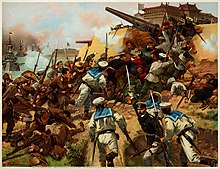Taku Forts
This article needs additional citations for verification. (June 2015) |
| Taku Forts | ||
|---|---|---|
Hanyu Pinyin | Báihé Diāobǎo | |
The Taku Forts or Dagu Forts, also called the Peiho Forts are
Binhai New Area, Tianjin, in northeastern China. They are located 60 km (37 mi) southeast of the Tianjin urban center.[1]
History
The first fort was built during the reign of the
Ming Jiajing Emperor between 1522 and 1527. Its purpose was to protect Tianjin from attack by wokou
sea raiders.
Later, in 1816, the Qing government built the first two forts on both sides of the Haihe estuary in response to increased concerns about seaborne threats from the West. By 1841, in response to the
spalling
and minimize penetration by artillery rounds. The forts were around 10 to 15 meters (33 to 49 ft) high, which located as they were in an exceedingly flat landscape, provided a critical vantage point.
Second Opium War

In 1856, Chinese soldiers boarded The Arrow, a Chinese-owned ship registered in
Treaties of Tianjin
were signed, which opened Tianjin to foreign trade.
In 1859, after China refused to allow the setting up of foreign legations in Beijing, a naval force under the command of British Admiral
Confederate Navy during the American Civil War, came to the assistance of the British gunboat HMS Plover, offering to take off their wounded. Plover's commander, Rear Admiral James Hope, accepted the offer and a launch was sent to take off the wounded. Later, Tattnall discovered that some of his men were black from powder flashes. When asked, the men replied that the British had been short handed with the bow gun. His famous report sent to Washington claimed "Blood is thicker than water". This was the first time the British troops needed American assistance after suffering major casualties from the Taku cannon barrage, and the first time that British and independent American troops fought side by side.[dubious
]
In 1860, an Anglo-French force gathered at Hong Kong and then carried out a landing at
Indian Medical Establishment became the youngest recipient of the Victoria Cross at the age of 15 years and 3 months.[2] The forts were severely mauled and General Sengge Rinchen's troops were forced to withdraw. On September 26, the force arrived at Beijing
and had captured the city by October 13.
Boxer Rebellion

After the
Battle of Taku Forts (1900), most of the forts were dismantled when the Eight-Nation Alliance Forces invaded China during the Boxer Rebellion
(1899–1901). Two forts remain today, one on the southern bank (the former "Wei" fort) and the other on the northern bank of the Hai River (the former "Hai" fort). Dagu Fort (on the southern bank) was repaired in 1988 and opened to the public in June 1997. Land reclamation has left it some considerable distance from the modern shoreline. Its restoration has not returned it to anything like the appearance it would have had when it was an active gun battery (see photo of the aftermath of the 1860 attack), but a number of cannons have been placed in the reconstructed gun embrasures to hint at its former use. An exhibition in Chinese recounts the history of the Opium Wars and the forts' role in them. Unrestored forts are visible to its north from Haifang Road.
Gallery
-
Interior of Angle of North Fort Immediately after Its Capture, 21 August 1860
-
Model of the Taku Forts in the Dagukou Fort Ruins Museum, Tanggu, China.
-
View of the gun platform from outside the defensive works.
-
Dedication plaque at the Dagukou Fort Ruins Museum.
-
View from inside the defensive works.
References
- ^ Edward Jewitt Wheeler; Isaac Kaufman Funk; William Seaver Woods (1900). The Literary Digest. pp. 68–69.
- ^ Imperial War Museum. "The Victoria Cross". archive.iwm.org.uk. Retrieved 5 April 2013.
- Colin Narbeth, Admiral Seymour's Expedition & Taku Forts 1900 (1980)
External links
Wikimedia Commons has media related to Taku Forts.
- The Queen's Royal Surrey Regimental Association. "TAKU FORTS 1860". Website of The Queen's Royal Surrey Regiment. Retrieved June 7, 2015.
- Hahn, Thomas H. "The Taku and Beitang Forts near Tianjin". Thomas H. Hahn Docu-Images. Retrieved June 7, 2015.





